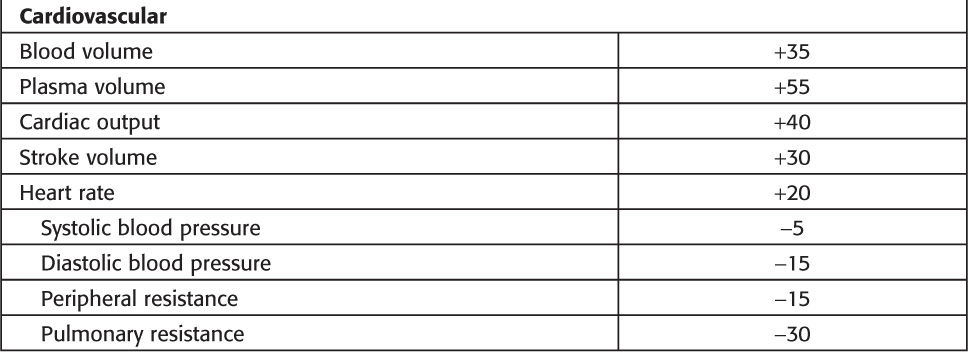• The minimal alveolar concentration (MAC) decreases by up to 40% at term and returns to normal by the third day after delivery.
Respiratory System
• Increased oxygen consumption (20%–50%), minute ventilation (50%), and tidal volume (40%) occur. Vital capacity and closing capacity are minimally affected. Functional residual capacity (FRC) decreases (20%). Rapid oxygen desaturation during periods of apnea can occur from the decrease in FRC and increase in oxygen consumption.
• Oxygen delivery to tissues improves secondary to an increase in P-50 for hemoglobin (from 27 to 30 mm Hg) and cardiac output.
• Paco2 decreases to 28 to 32 mm Hg; significant respiratory alkalosis is prevented by decreased plasma bicarbonate concentration.
• Capillary engorgement of the respiratory mucosa can predispose the upper airways to trauma and obstruction.
Cardiovascular System
• Cardiac output increases (40%) at term because of increases in heart rate (15%–20%) and stroke volume (30%). The greatest increases in cardiac output are seen during labor and immediately after delivery; it does not return to normal until 2 weeks after delivery.
• Systemic vascular resistance decreases by the second trimester.
• Aortocaval compression from near or complete occlusion of the inferior vena cava by the gravid uterus can lead to pallor, sweating, or nausea and vomiting. Compression of the aorta decreases blood flow to the lower extremities and the uteroplacental circulation.
• Renal plasma flow and the glomerular filtration rate increase during pregnancy, and as a result serum creatinine and blood urea nitrogen may decrease. A decreased rental tubular threshold for glucose and amino acids is common and may result in mild glycosuria. Plasma osmolality decreases by 8–10 mOsm/kg
Gastrointestinal Effects
• Gastroesophageal reflux and gastritis is common. Gastric motility is reduced, and upward and anterior displacement of the stomach by the uterus promotes incompetence of the gastroesophageal sphincter. Neither gastric acidity nor gastric volume changes significantly during pregnancy.
Hepatic Effects
• Hepatic function and blood flow do not change. Minor elevations in serum transaminases and lactic dehydrogenase levels may be observed in the third trimester.
• Serum albumin is mildly decreased from the expanded plasma volume; therefore, colloid oncotic pressure is reduced. Pseudocholinesterase activity is decreased by 25% to 30% at term.
• High progesterone levels inhibit the release of cholecystokinin, resulting in incomplete emptying of the gallbladder and possibly the formation of cholesterol gallstones during pregnancy.
Hematologic Effects
• Parturients exhibit a hypercoagulable state; fibrinogen and the concentration of factors VII, VIII, IX, X, and XII concentrations all increase (only factor XI levels may decrease).
• Accelerated fibrinolysis and a decrease in platelet count by up to 10% may be seen in the third trimester. Dilutional anemia, leukocytosis, and decreased cell-mediated immunity also occur.
Uteroplacental Circulation
Uterine blood flow: Represents about 10% of the cardiac output, or 600 to 700 mL/min (compared with 50 mL/min in the nonpregnant uterus). A total of 80% of uterine blood flow normally supplies the placenta; the remainder goes to the myometrium. Pregnancy maximally dilates the uterine vasculature, so autoregulation is absent. Extreme hypocapnia (PaCO2 <20 mm Hg) can reduce uterine blood flow and causes fetal hypoxemia and acidosis. Blood flow is directly proportionate to the difference between uterine arterial and venous pressures but inversely proportionate to uterine vascular resistance. The uterine vasculature has α-adrenergic and possibly some β-adrenergic receptors.
Factors that decrease uterine blood flow during pregnancy: (1) Systemic hypotension (from aortocaval compression, hypovolemia, and sympathetic blockade after regional anesthesia), (2) uterine vasoconstriction (from stress-induced release of catecholamines or administration of drugs with α-adrenergic activity), and (3) uterine contractions (this elevates uterine venous pressure and may compress arterial vessels as they traverse the myometrium).
Vasopressor selection: Ephedrine, which has predominantly β-adrenergic activity, has traditionally been considered the vasopressor of choice for hypotension during pregnancy. However, clinical studies suggest that α-adrenergic agonists such as phenylephrine and metaraminol are just as effective in treating hypotension in pregnant patients and are associated with less fetal acidosis than ephedrine.

Full access? Get Clinical Tree






